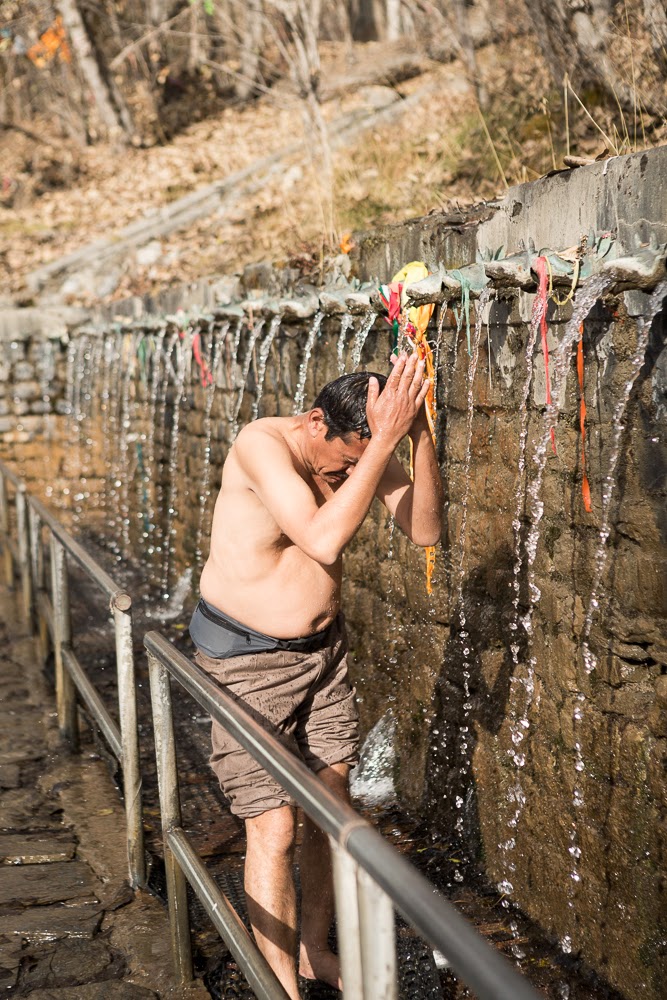 |
| Nepal - People and Culture With this set of pictures I hope to give you a feel for the people and culture of Nepal. Most of these pictures were taken in the mountain towns in Annapurna area. |
 |
| Walking was the primary mode of transportation. |
 |
| This man was butchering a goat. He had strips of meat drying on a rack. |
 |
| Corn, millet, apples, and vegetables were grown in the fields. Harvesting was by hand. |
 |
| This lady is crushing what appeared to be cedar leaves for incense. The stone was quite heavy. |
 |
| Storage area beneath a house. |
 |
| Water buffalo are used to plow the fields. |
 |
| Almost everything is carried in baskets with a strap across the forehead. Villagers travel quite a ways to collect wood. |
 |
| Animals are kept in the towns. Corn stocks are brought into town for forage. |
 |
| Every town seem to have monks and most had monasteries. Culturally your first born and last born sons stay with the family. All of the other sons become monks. |
 |
| It was wash day and this woman had a small helper. |
 |
| Most of the laundry was done in the local rivers and creeks. |
 |
| Stone Chortans are part of Buddhist culture and can be found throughout the mountains. |
 |
| There are large flocks of goats. They are bought back to town each evening. It is hard to believe that there is enough for them to eat on these slopes. You can find woven good made from goat and yak. |
 |
| Shepard watching over his flock as sunset approaches. |
 |
| Prayer wheels are often aligned around Buddhist shrines and are set in motion by pilgrims who circum-ambulate the building in a clockwise direction |
 |
| Harvesting cabbage. |
 |
| One of our Nepali guides doing a little flying. |
 |
| Live stock freely walked the streets of the mountain towns. |
 |
| A one log bridge. Local villages had constructed log bridges across this river. There is a three log bridge across a wider, deeper section of the river. |
 |
| This courtyard is in the old section of Kagbeni. Historically Kagbeni was a trading center set between the Mustang Kingdom and Nepal. |
 |
| Sheep on the run. We saw very few sheep herds. Mostly goats. |
 |
| We went to a large temple in Muktinath. There are a 108 cow head spouts. Hindus walk through this holy water saying prayers. Since this site is at 12,000 feet the water is quite cold. |
 |
| One of our guides walking through the holy waters. |
 |
| There were also two plunge pools at the temple. |
 |
| You can tell the water is quite cool. |
 |
| The most common prayer wheels we saw were brass. |
 |
| Most of the older homes we saw were rammed mud homes. The next generation of homes were stone with mud mortar. Now they are building homes from concrete blocks. The blocks are made on site. |
 |
| All of the homes in this small town had this interesting paint scheme. |
 |
| Our guide pretending to rest after we climbed up to the snow line. |
 |
| Horses are primarily used as pack animals. |
 |
| This Yak was headed to the fields. |
 |
| Local holy man. |
 |
| Manure was collected from the pens in town and bagged by the women. Then the men put the bags onto horses and took the manure to the fields were it will be spread as fertilizer. |
 |
| Chicken feeding time. |
 |
| Young girl checking out the photographers while her mom cooked us lunch. |
 |
| Bell in a Buddhist Temple |
 |
| Nepali flag and view from a temple roof. |
 |
| Dal Bhat is the traditional Nepali meal. These ladies are preparing our lunch. |
 |
| Traffic jam. We had to wait for pack horses and these yaks before we could cross the bridge. |
 |
| Back to Kathmandu for our last day in Nepal. We visited the retail and wholesale market. |
 |
| Children ran up to you asking to have their picture taken. This boy's mom staged him for this picture. |
 |
| Spices |
 |
| Street vendors would ride their bicycles or motorcycles to the wholesale market, buy their products, load up, and head to their street locations. |
 |
| Wholesale vendor |
 |
| Headed out. |
 |
| We went to a local Nepali home for lunch. This is grandma. |
 |
| Her granddaughter did much of the cooking and talked us through the process. |
 |
| Our lunch. |
 |
| Mom firing up Resurrection Bread. |
 |
| After lunch we headed to Pashupati. A Hindu religious site were the dead are cremated along side a river. There are holy men here who are called Sadhus. |
 |
| Sadhus give up all material goods and rely on the generosity of others. |
 |
| They like to be photographed but expect a small donation. The equivalent of a dollar. |









No comments:
Post a Comment